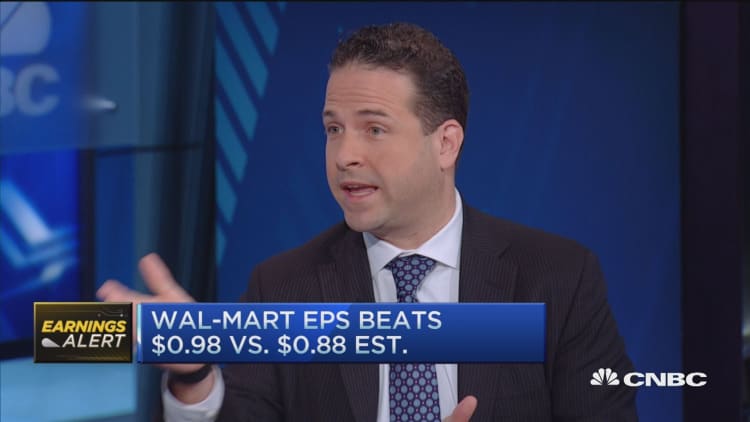
Look out, retailers: Wal-Mart is hungry for growth, and on the menu is more of your lunch.
On a call with investors after its big first-quarter beat Thursday, the world's largest retailer said it would forge ahead more quickly on its "investments in price" that began late in the fiscal period. Wal-Mart said it lowered prices on "key items in select geographies," which helped drive its performance during the latest period.
The company's update comes as retailers across the space are already grappling with too much inventory, a consumer addiction to discounts and blockbuster growth among other low-price players, all of which are contributing to price deflation. And with competitors that tend to follow its lead (remember the list of retailers who raised their wages in Wal-Mart's wake?) further price cuts across the space seem inevitable.
Making things even tougher for its peers are improving operations within Wal-Mart's stores, as management — now two years under CEO Doug McMillon — has said it's no longer enough to compete on just price.
"We're going to see margin compression for retailers," Moody's analyst Charlie O'Shea said. "The question is ... how low can you go?"
Wal-Mart spokesman Randy Hargrove told CNBC it's too early to provide details on its pricing strategy. But back in October, when the chain first announced the billions of dollars it would invest in prices over the next two years, U.S. Chief Greg Foran said the company knew where the gaps were. He and McMillon added there are certain categories in which price is more important, including consumer packaged goods, which can be purchased at other retailers.
O'Shea said he's already noticed lower prices in Wal-Mart's food offerings, and he expects further price cuts in food and health and beauty aids. Those categories offer the most bang for their buck, because they're purchased more frequently than such discretionary merchandise as apparel. That equates to more store visits.
If Wal-Mart were to further cut its food prices, it could be detrimental to grocers. These retailers, who by nature are up against razor-thin margins, are also battling against food deflation. But Wal-Mart, which sells a swath of products, is able to use food as a means for driving traffic to its stores, in hopes that shoppers will add more profitable items to their baskets. These include its private-label offerings, which are less costly for shoppers and more profitable for retailers.
Adding more fuel to the fire is Wal-Mart's expansion of its grocery pickup service, which allows its customers to order groceries online and pick them up at the store. Though the retailer would not offer specifics on the number of shoppers who use this service, it is quickly being rolled out. The retailer is adding nine new markets to the fold this month, and will be in roughly 40 by the end of May. Grocery already accounts for more than half of Wal-Mart's annual revenue.
In addition to grocers, analysts identified dollar stores, general merchandise competitor Target and apparel players as the most likely to lose share to Wal-Mart's promotions.
"The bottom line here is that retailers are going to have to react," O'Shea said.
He cautioned, however, that retailers can't try to compete solely on price. He pointed to Toys R Us as an example of how a company can leverage its position as a category leader to work with vendors on exclusive products that shoppers can't buy elsewhere.
"You're competing with someone with the best logistics network in retail [and] the most favorable vendor relationships in retail, so the deck is stacked against you," he said.
The deck is only getting stacked higher under McMillon's leadership. The CEO has been pushing for a better in-store experience, including quicker checkout, fewer cases of out-of-stock merchandise and cleaner locations. Combined with other initiatives, including paying its associates more, his strategy has contributed to six straight quarters of increased footfall in its established stores. As its store operations continue to improve, competitors will need to work harder to get their share of consumers' wallets.
Craig Johnson, president of Customer Growth Partners, said Wal-Mart has also done a better job at bringing in customers for fill-in trips, where shoppers scoop up small items such as milk to tide them over until their big shopping trip. It's done so, in part, by making small changes at its stores, such as offering small handbaskets in addition to carts.
These fill-in trips likely contributed to the lower average spending per shopper during the quarter, Johnson said.
"[Price] is only part of what's going on," Johnson said. "They're doing some of the things that they've needed to do. They're doing it right and they're doing it better."
The world's largest retailer beat analysts' estimates on both the top and bottom lines during the first quarter, and called for another 1 percent lift in its domestic comparable sales for the current quarter. Still, it maintained its full-year earnings per share forecast of $4 to $4.30 a share.
On media call, CFO Brett Biggs said although low inflation, cheap fuel prices and low interest rates continue to help the consumer, "there is still an air of uncertainty with consumers and how they continue to spend their money."
That was also evident in Target's second-quarter guidance, with Wal-Mart's big-box competitor saying its sales in that period were off to a soft start.
"The consumer's spending where they want," JPMorgan analyst Chris Horvers told CNBC. "If you're where the consumer is and you're executing, you can do well."
— CNBC's Courtney Reagan contributed to this report.









